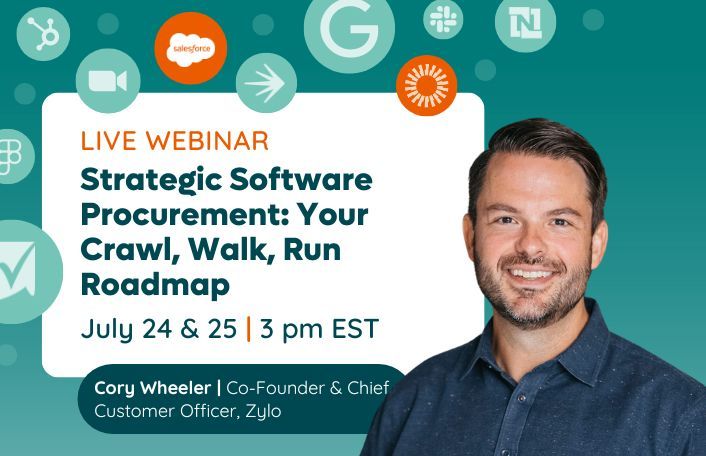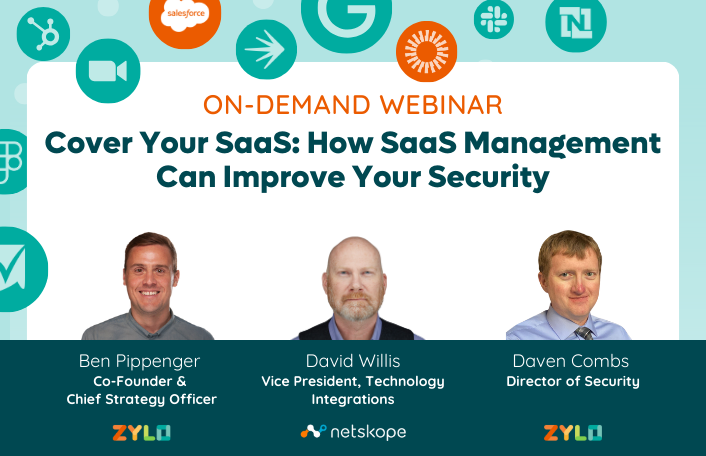

The Enterprise Saas Management Playbook
It’s no secret that managing an entire stack across an organization, including shadow IT, is a big challenge. It’s a challenge that’s not just isolated to IT since SaaS applications are purchased all over the organization at the business level, the team level, and the individual level. This makes it all the more important to create a SaaS management playbook to be socialized throughout the business.
Managing SaaS for an Enterprise Organization is Unique
Managing SaaS at a smaller or midsize business where deployment of new initiatives can happen quickly is a different animal than managing SaaS at the enterprise level where IT leaders are accounting for SaaS applications deployed across thousands of users rather than hundreds or less.
We’ll be sharing three high-level plays for developing an enterprise SaaS management strategy.
Play 1: Line Up the Big Picture
First, let’s take a look at the overall market. Gartner predicts that SaaS spending will grow by about 18% in 2019 alone. Within the overall cloud market, Saas accounts for about 40% of all spending – or about $85.1 billion, the largest share of the cloud market overall.
These numbers are important because that spending is heavily driven by enterprise investments in SaaS, making an enterprise SaaS management strategy all the more important.
So lining up the big picture for Saas enterprise strategy involves defining a starting SaaS strategy, capturing an accurate inventory of your current SaaS application footprint, including shadow IT, and then collaborating across the business via a system of record.
Define a Starting SaaS Strategy
The first step of lining up the big picture is to kick off a process and strategy for creating an accurate view of your current SaaS application catalog. Answer the question: Why does the organization want or need to undertake this initiative?
With that viewpoint in place, you can then define a high-level organizational strategy. This strategy is different for everyone but once an accurate inventory is made available, the business can then prioritize the right strategy.
A few examples of starting strategies from Zylo’s experience working with enterprise customers:
- Discover all shadow IT – Some organizations simply want an honest accounting of the costs and the sources of costs, as well as understanding what tools and risks are in the organization, both the known and unknown.
- Understand the risks to privacy, security, and compliance – Similar to discovering shadow IT, once discovered, many organizations want to fully understand the scope of the problem and their susceptibility to multiple risk factors.
- Measure application adoption and usage – If the organization has discovered SaaS tools throughout the organization, many seek to answer questions about how are they being adopted or used.
- Contain costs, improve ROI – Lastly, the primary starting strategy for many enterprise organizations revolves around reducing unplanned costs and getting as much value as possible from their SaaS investment.
Capture the Current State
The second step is to design a mechanism to capture the current state of the SaaS inventory. Across Zylo’s customer base, more than 50 percent of SaaS purchase transactions occur outside of IT. That translates to customers underestimating the number of SaaS applications in their business by two to three times.
And with hundreds of more applications than expected in their inventory, enterprises are averaging two SaaS application renewals every business day.
If this sounds like your organization, you’re not alone. Zylo recently hosted its first SaaS Management Network with some of our most tech-forward customers ranging from decades-old companies with 50,000 employees to hot new startups scaling at break-neck speed.
Even these companies acknowledge that they are just starting to learn the needs for enterprise SaaS management and starting here at what we call the discovery stage.
How to Capture the Current State of SaaS
Many organizations will use a spreadsheet to capture this information. Whether it starts in procurement or finance teams, using a spreadsheet to capture your SaaS inventory is a manual effort with flaws. First, the sheet will be stale as soon as you’ve updated it. It can also be a heavy lift across multiple cross-functional teams.
We believe an enterprise SaaS management tool or platform is better for a few reasons. This approach creates a single view of all SaaS discovery. It’s integrated into existing systems such as your AP, expenses, single sign-on and direct usage integrations into the most popular business apps.
All SaaS records can be regularly updated with little to no effort to continuously find those undiscovered SaaS tools you’re looking for.
Collaborate from a Single Source of Truth
The single source of truth is the inventory or catalog that’s been created by the discovery process. Once you have defined a strategy and completed a full discovery, talk to your stakeholder teams, including those responsible for legal, financial, security and compliance.
Answers to questions like these can help inform the next steps:
- What are the biggest issues that they need to be fixed right away?
- Is the data provided by the discovery process accurate?
- Do these teams have the full context around the deployment of the shadow tools that you’re just now learning about?
- What about application redundancies or duplicates that we can eliminate?
- How does our SaaS management align with the overall enterprise strategy?
The bottom line is that you want to establish a shared single source of truth that can be customized to provide value to all shareholders.
Play 2: Get Your Teams in the Game
Getting your teams in the game is all about empowering responsible SaaS ownership where it makes sense, defining managed and unmanaged application thresholds for your teams, and delivering best practices for SaaS team management.
Empower Responsible SaaS Ownership
More than 50% of all SaaS application spending is occurring outside of IT’s budget. Because the adoption and use of SaaS is growing rapidly, many IT teams won’t regain ownership.
For many organizations, it’s time to consider embracing and overcoming shadow IT by discovering all the SaaS applications within your organization and then establishing the governance framework that allows for control and flexibility.
A good example that illustrates this point is the popular marketing technology landscape graphic, and I’m sure a lot of folks have seen. It’s an annual accounting of every technology application available for marketing teams,growing from about 150 applications in 2011 to approximately 7,000 today.
There are two takeaways illustrated by this graphic. One, SaaS is continually undergoing rapid growth, so any knowledge of the known universe is quickly outdated.
Two, now more than ever, IT must rely on specialists within the organization. For example, your CMO or marketing leader will likely have a deeper, more effective understanding of the marketing tech landscape and how that can be used for their business unit.
From this perspective, the role of the IT leader now shifts to enabling teams to use the software that makes them and their departments more effective. If your organization embraces this idea, it then becomes the responsibility of the progressive CIO or IT director to allow their teams to buy the software they need (within reason), but also monitor that inventory and provide a governance framework that delivers best practices.
Managed SaaS vs. Unmanaged SaaS
When we talk about embracing shadow IT, many larger organizations are beginning to take a look at this approach of managed versus unmanaged applications. For smaller organizations, determining managed versus unmanaged applications is less of an issue because their SaaS application stack is capable of being fully managed by a centralized team.
But with fast-growing and larger customers, this is a concept that resonates. For these teams, centrally managed versus unmanaged or distributed ownership may already be the status quo. There is likely already a pool of enterprise SaaS apps that are centrally managed and also tools that have been purchased across the business with varying degrees of management.
How to Define SaaS Management Types
When we work with enterprise organizations about how they organize managed versus unmanaged SaaS, there are a few key deciding factors to consider.
- Mission critical function – Is this SaaS application mission critical to the enterprise? Is it running core processes of, pieces of our product or customer journey? If yes, it typically ends up being centrally managed.
- Spans multiple teams or cost centers – Is this application deployed horizontally across multiple teams within the organization? If the application wasn’t centrally managed, would multiple cost centers independently purchase this tool? If yes, the application should be centrally managed.
- Overall cost – Does it carry a high cost of business where these licenses really are pricey to be running on a per user basis? If yes, these tools tend to fall into a managed category as well.
Delivering Best Practices for Enterprise SaaS Management
A critical part of adopting a managed versus unmanaged philosophy for enterprise SaaS management is ensuring that teams follow best practices. Here are a few examples where best practices must be developed.
- Continual discovery
- On-boarding and implementation
- Risk mitigation
- Utilization and licensing
- Renewal management
Play 3: Measure and Plan the Future
Now that the groundwork for an enterprise SaaS management strategy has been laid, you can talk about measuring what matters for your organization, including building reports to foster collaboration and setting benchmarks to drive business decision making.
Once benchmarks are established, enterprise teams can begin defining an enterprise SaaS management life cycle to plan for the future.
Build benchmarks to inform decision making
The system of record created by using a discovery process to capture all SaaS applications is the key component to creating benchmarks for decision making.
Here are some metrics that Zylo customers use to help them and their teams make decisions for enterprise SaaS applications:
- SaaS spending – Comparing SaaS spend year over year against other growth metrics to ensure that spending on SaaS isn’t outpacing other areas of business investment. You could compare SaaS spending against employee headcount or revenue growth to help forecast when new processes will be needed to derive more value from your SaaS investment.
- Utilization – Creating a measurement of your SaaS tools usage allows you to identify value opportunities. For example, don’t continue to pay for tools you or your teams are not using.
- Adoption – This is more about measuring the effectiveness of tool deployment and driving first-time and ongoing use where needed. Successfully measuring adoption creates more effective deployment plans when new SaaS applications are introduced to the business.
- Employee experience – Polling internal employee satisfaction measures with SaaS applications and adding that data to utilization and adoption measures creates a more holistic view of tools within the organization.
Create Planning with a SaaS Management Life Cycle
With benchmarks in place, many organizations can begin defining a prototypical SaaS management life cycle that begins to define what actions take place when certain SaaS application events take place.
For instance, when a new SaaS application is requested, what kind of review process takes place to make sure it meets the organization standards for security and other risk prevention?
Another example: When an application has entered the organization, but utilization or adoption is measured and shown to be low, what actions need to be taken?
And finally, when an application approaches its renewal date or vendor notification period, what kinds of activities and review needs to occur to approve the application’s renewal for another term or to determine its time to offboard it?
These types of questions aren’t easy to answer, and the processes and effort required are complex, but with a prototypical life cycle in place, the activities that need to be executed for each period become more concrete and proactive.
What It All Means in the Big Picture
Creating an enterprise SaaS management strategy is a complex and time-intensive process. It relies on a clear discovery process accurately portray the current state of SaaS applications present in the business and strong collaboration among stakeholders to align organizational goals with the defined strategy specific for SaaS.
However, like any process, once the process becomes repeatable and iterative through the use of benchmarking and life cycle-focused management, enterprise organizations can unlock the full potential of their SaaS investment.




